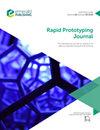克服材料挤压(MEX) 3D打印机床身尺寸限制的搅拌摩擦点焊研究
IF 3.6
4区 工程技术
Q1 ENGINEERING, MECHANICAL
引用次数: 0
摘要
材料挤压(MEX) 3D打印机由于其受限的床身尺寸而受到小尺寸打印的固有限制。另一方面,搅拌摩擦点焊(FSSW)正受到汽车、飞机、越野设备制造商甚至消费电子产品制造商的广泛关注。本文旨在探索FSSW在丙烯腈-丁二烯-苯乙烯/聚乳酸3D打印部件上的可能性,以克服MEX 3D打印机床层尺寸的限制。设计/方法/方法四种不同的刀具几何形状(带/不带凹度的锥形圆柱销,带/不带凹度的无销)用于生产接头。利用Taguchi L27实验设计,研究了与FSSW相关的三个关键工艺参数(工具转速、插入深度和停留时间)和与3D打印相关的两个关键工艺参数(材料组合和填充百分比),并对其进行了优化。通过方差分析评价了各焊接参数对抗剪强度的影响。结果表明,3D打印参数填充率对接头强度影响最大。接头呈现拉核、交叉核和基体破坏形态。结果表明,接头效率高达100.3%,优于其他3d打印热塑性塑料的竞争工艺。将其应用于无人机机翼的焊接,显示出良好的强度和完整性。此外,还研究了尼龙微粒接枝对接头强度的不利影响。据作者所知,这是第一个研究表明,通过FSSW可以焊接带有/不带有微颗粒的不同3d打印热塑性塑料,而工艺参数对粘合强度有相当大的影响。本文章由计算机程序翻译,如有差异,请以英文原文为准。
Investigations on friction stir spot welding to overcome bed size limits of material extrusion (MEX) 3D printers
Purpose Material extrusion (MEX) 3D printers suffer from an intrinsic limitation of small size of the prints due to its restricted bed dimension. On the other hand, friction stir spot welding (FSSW) is gaining wide interest from automobile, airplane, off-road equipment manufacturers and even consumer electronics. This paper aims to explore the possibility of FSSW on Acrylonitrile Butadiene Styrene/Polylactic acid 3D-printed components to overcome the bed size limitation of MEX 3D printers. Design/methodology/approach Four different tool geometries (tapered cylindrical pin with/without concavity, pinless with/without concavity) were used to produce the joints. Three critical process parameters related to FSSW (tool rotational speed, plunge depth and dwell time) and two related to 3D printing (material combination and infill percentages) were investigated and optimized using the Taguchi L27 design of experiments. The influence of each welding parameter on the shear strength was evaluated by analysis of variance. Findings Results revealed that the infill percentage, a 3D printing parameter, had the maximum effect on the joint strength. The joints displayed pull nugget, cross nugget and substrate failure morphologies. The outcome resulted in the joint efficiency reaching up to 100.3%, better than that obtained by other competitive processes for 3D-printed thermoplastics. The results, when applied to weld a UAV wing, showed good strength and integrity. Further, grafting the joints with nylon micro-particles was also investigated, resulting in a detrimental effect on the strength. Originality/value To the best of the authors’ knowledge, this is the first study to demonstrate that the welding of dissimilar 3D-printed thermoplastics with/without microparticles is possible by FSSW, whilst the process parameters have a considerable consequence on the bond strength.
求助全文
通过发布文献求助,成功后即可免费获取论文全文。
去求助
来源期刊

Rapid Prototyping Journal
工程技术-材料科学:综合
CiteScore
8.30
自引率
10.30%
发文量
137
审稿时长
4.6 months
期刊介绍:
Rapid Prototyping Journal concentrates on development in a manufacturing environment but covers applications in other areas, such as medicine and construction. All papers published in this field are scattered over a wide range of international publications, none of which actually specializes in this particular discipline, this journal is a vital resource for anyone involved in additive manufacturing. It draws together important refereed papers on all aspects of AM from distinguished sources all over the world, to give a truly international perspective on this dynamic and exciting area.
-Benchmarking – certification and qualification in AM-
Mass customisation in AM-
Design for AM-
Materials aspects-
Reviews of processes/applications-
CAD and other software aspects-
Enhancement of existing processes-
Integration with design process-
Management implications-
New AM processes-
Novel applications of AM parts-
AM for tooling-
Medical applications-
Reverse engineering in relation to AM-
Additive & Subtractive hybrid manufacturing-
Industrialisation
 求助内容:
求助内容: 应助结果提醒方式:
应助结果提醒方式:


